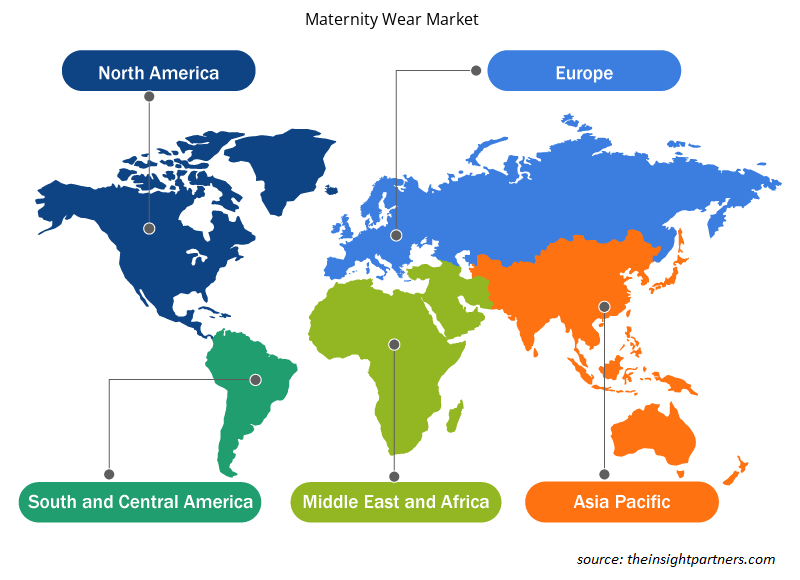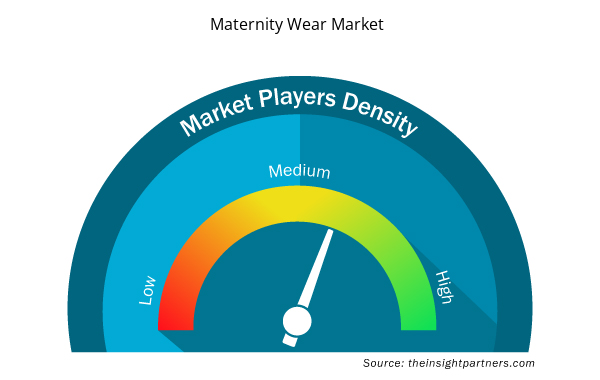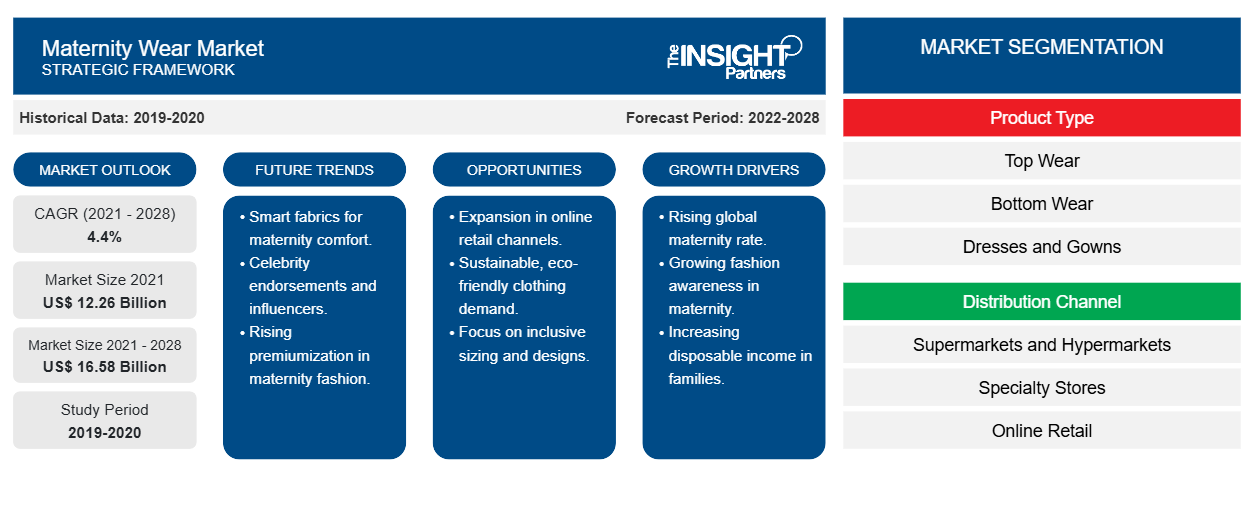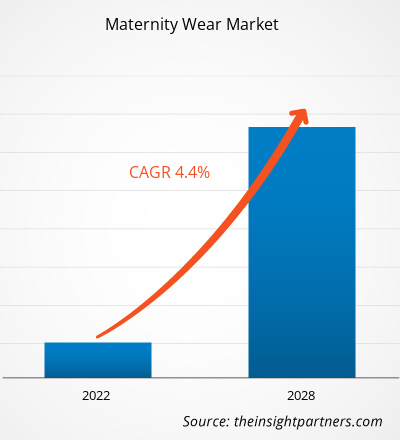Il mercato dell'abbigliamento premaman è stato valutato 12.257,41 milioni di dollari nel 2021 e si prevede che raggiungerà 16.578,64 milioni di dollari entro il 2028; si prevede una crescita a un CAGR del 4,4% dal 2021 al 2028.CAGR of 4.4% from 2021 to 2028.
Gli abiti premaman sono solitamente realizzati con una vestibilità comoda e comoda, dotati di elastici, linguette e tessuti elastici, come elastan e spandex, per offrire maggiore comfort alla consumatrice durante la gravidanza.
L'Asia-Pacifico ha detenuto la quota maggiore del mercato globale dell'abbigliamento premaman nel 2020, mentre si prevede che il Nord America registrerà il CAGR più elevato durante il periodo di previsione. Secondo il rapporto della Banca Mondiale, negli Stati Uniti c'è una media dell'85% di donne lavoratrici incinte. Pertanto, la domanda di abbigliamento premaman e taglie forti nell'abbigliamento formale nella sezione abiti e abiti da sera formali è in aumento. Questo è un fattore importante che contribuisce alla crescita del mercato dell'abbigliamento premaman in Nord America.
Impatto della pandemia di COVID-19 sul mercato dell'abbigliamento premaman
La pandemia di COVID-19 ha avuto effetti negativi su molti settori, tra cui quello dei beni di consumo. La pandemia ha creato difficoltà operative dovute a lockdown, chiusure aziendali e interruzioni della catena di fornitura. I negozi al dettaglio di abbigliamento e vestiario hanno registrato perdite elevate nelle vendite. I risultati finanziari pubblicati da marchi di moda come lo spagnolo Inditex Group e lo svedese H&M hanno messo a nudo l'enormità dell'impatto della pandemia. Inoltre, l'e-commerce ha tratto un beneficio duraturo dalla pandemia, poiché la maggior parte degli acquirenti online considera l'e-retail come un'opzione post-pandemia. Inoltre, si prevede che l'aumento dei tassi di vaccinazione, la ripresa delle attività manifatturiere e l'allentamento delle normative governative influenzeranno positivamente il mercato globale dell'abbigliamento premaman durante il periodo di previsione.
Personalizza questo report in base alle tue esigenze
Riceverai la personalizzazione gratuita di qualsiasi report, comprese parti di questo report, o analisi a livello nazionale, pacchetto dati Excel, oltre a usufruire di grandi offerte e sconti per start-up e università
- Scopri le principali tendenze di mercato in questo rapporto.Questo campione GRATUITO includerà analisi di dati che spaziano dalle tendenze di mercato alle stime e alle previsioni.
Approfondimenti di mercato
L'adozione di strategie di crescita aziendale stimola la crescita del mercato
I player affermati nel mercato adottano varie strategie per superare le sfide attuali e future per l'espansione dell'azienda. Ad esempio, Isabella Oliver ha adottato una strategia di penetrazione del mercato lanciando un programma di noleggio di abiti premaman per migliorare la propria portata. Il 20 gennaio 2020, il marchio ha nuovamente lanciato un nuovo programma di noleggio per diventare circolare e aumentare la longevità degli abiti premaman. Isabella Oliver ha offerto ai suoi clienti la nuova gamma di opzioni per noleggiare un abito, inclusi abiti da festa e articoli essenziali per la gravidanza, per due settimane, prima di restituirlo gratuitamente. Il marchio si occupa persino della pulizia a secco. I clienti possono anche acquistare il prodotto. L'idea di noleggiare abiti premaman è quella di incoraggiare i clienti a diventare più ecologici ed eliminare gli effetti della fast fashion. Quindi, le innovazioni e le penetrazioni del prodotto hanno portato a un aumento della domanda di abiti premaman. Questi fattori stanno guidando la crescita del mercato dell'abbigliamento premaman.
Informazioni sui canali di distribuzione
In base al canale di distribuzione, il mercato dell'abbigliamento premaman è segmentato in supermercati e ipermercati, negozi specializzati, vendita al dettaglio online e altri. Si prevede che il segmento della vendita al dettaglio online registrerà il CAGR più elevato durante il periodo di previsione. L'e-commerce ha svolto un ruolo fondamentale durante i mesi iniziali della pandemia di COVID-19, poiché ai negozi al dettaglio fisici non era consentito operare. Durante i lockdown, le persone hanno utilizzato sempre di più le piattaforme di e-commerce per acquistare prodotti essenziali e non essenziali. La crisi economica dovuta allo scoppio del COVID-19 ha comportato una riduzione del reddito disponibile delle donne. Tuttavia, la domanda di abbigliamento premaman non è stata influenzata. Di conseguenza, è probabile che i prezzi competitivi diventino una caratteristica fondamentale dell'intero panorama in futuro. Si prevede che questo fattore rafforzerà potenzialmente la crescita del mercato per il segmento della vendita al dettaglio online durante il periodo di previsione.CAGR during the forecast period. E-commerce played a vital role during the initial months of the COVID-19 pandemic, as physical retail stores were not permitted to operate. During lockdowns, people increasingly used e-commerce platforms to buy essential and nonessential products. The economic crisis due to the COVID-19 outbreak resulted in reduced disposable incomes of women. However, the demand for maternity wear was not affected. As a result, competitive pricing is likely to become a key feature of the complete landscape in the future. This factor is projected to potentially bolster the market growth for the online retail segment during the forecast period.
Informazioni sul tipo di prodotto
In base al tipo di prodotto, il mercato dell'abbigliamento premaman è suddiviso in top wear, bottom wear, abiti e abiti da sera e biancheria intima . Il segmento top wear ha rappresentato una quota di mercato maggiore nel 2020 e si prevede che il segmento abiti e abiti da sera registrerà un CAGR più elevato durante il periodo di previsione. L'abbigliamento premaman è composto da abbigliamento formale e casual. Inoltre, la domanda di abbigliamento premaman formale è in aumento a causa del crescente numero di donne lavoratrici. L'abbigliamento premaman formale è composto da kurti, camicette, abiti canotta in materiale morbido, blazer e trench con doppio strato. L'abbigliamento casual comprende tuniche, maxi abiti e felpe e t-shirt oversize. Gli abiti premaman sono realizzati con tessuti della migliore qualità con materiali naturali e confortevoli, come cotone, modal e bambù , poiché sono morbidi e consentono una respirazione costante. Le donne incinte tendono a scegliere il materiale in base ai cambiamenti stagionali. In estate, preferiscono tessuti di lino termorepellenti per un facile flusso d'aria, mentre in inverno, sono preferiti cappotti di lana caldi per prevenire il freddo.
Tra i principali attori del mercato dell'abbigliamento premaman ci sono Gap Inc, Seraphine, Isabella Oliver, H and M Hennes e Mauritz AB, Brunelli and Co SRL, Mothercare, Boob Design, SHAICO Fashion Pvt. Ltd, Pink Blush Maternity e Organic & More.
Approfondimenti regionali sul mercato dell'abbigliamento premaman
Le tendenze regionali e i fattori che influenzano il mercato dell'abbigliamento premaman durante il periodo di previsione sono stati ampiamente spiegati dagli analisti di Insight Partners. Questa sezione discute anche i segmenti e la geografia del mercato dell'abbigliamento premaman in Nord America, Europa, Asia Pacifico, Medio Oriente e Africa e Sud e Centro America.

- Ottieni i dati specifici regionali per il mercato dell'abbigliamento premaman
Ambito del rapporto sul mercato dell'abbigliamento premaman
| Attributo del report | Dettagli |
|---|---|
| Dimensioni del mercato nel 2021 | 12,26 miliardi di dollari USA |
| Dimensioni del mercato entro il 2028 | 16,58 miliardi di dollari USA |
| CAGR globale (2021 - 2028) | 4,4% |
| Dati storici | 2019-2020 |
| Periodo di previsione | 2022-2028 |
| Segmenti coperti | Per tipo di prodotto
|
| Regioni e Paesi coperti | America del Nord
|
| Leader di mercato e profili aziendali chiave |
|
Densità degli attori del mercato: comprendere il suo impatto sulle dinamiche aziendali
Il mercato del mercato dell'abbigliamento premaman sta crescendo rapidamente, spinto dalla crescente domanda degli utenti finali dovuta a fattori quali l'evoluzione delle preferenze dei consumatori, i progressi tecnologici e una maggiore consapevolezza dei vantaggi del prodotto. Con l'aumento della domanda, le aziende stanno ampliando la propria offerta, innovando per soddisfare le esigenze dei consumatori e capitalizzando sulle tendenze emergenti, il che alimenta ulteriormente la crescita del mercato.
La densità degli operatori di mercato si riferisce alla distribuzione di aziende o società che operano in un particolare mercato o settore. Indica quanti concorrenti (operatori di mercato) sono presenti in un dato spazio di mercato in relazione alle sue dimensioni o al valore di mercato totale.
Le principali aziende che operano nel mercato dell'abbigliamento premaman sono:
- Gap Inc
- Serafina
- Isabella Oliver
- H & M Hennes e Maurits
- Brunelli & Co. SRL
Disclaimer : le aziende elencate sopra non sono classificate secondo un ordine particolare.

- Ottieni una panoramica dei principali attori del mercato dell'abbigliamento premaman
Segnala i riflettori
- Tendenze progressive del settore nel mercato dell'abbigliamento premaman per aiutare gli operatori a sviluppare strategie efficaci a lungo termine
- Strategie di crescita aziendale adottate dai mercati sviluppati e in via di sviluppo
- Analisi quantitativa del mercato dell'abbigliamento premaman dal 2019 al 2028
- Stima della domanda globale di ingredienti lattiero-caseari
- Analisi delle cinque forze di Porter per illustrare l'efficacia degli acquirenti e dei fornitori che operano nel settore
- Sviluppi recenti per comprendere lo scenario competitivo del mercato
- Tendenze e prospettive del mercato, nonché fattori che guidano e frenano la crescita del mercato dell'abbigliamento premaman
- Assistenza nel processo decisionale evidenziando le strategie di mercato che sostengono l'interesse commerciale, portando alla crescita del mercato
- La dimensione del mercato dell'abbigliamento premaman in vari nodi
- Panoramica dettagliata e segmentazione del mercato, nonché dinamiche del settore dell'abbigliamento premaman
- Dimensioni del mercato dell'abbigliamento premaman in diverse regioni con promettenti opportunità di crescita
- Analisi storica (2 anni), anno base, previsione (7 anni) con CAGR
- Analisi PEST e SWOT
- Valore/volume delle dimensioni del mercato - Globale, regionale, nazionale
- Industria e panorama competitivo
- Set di dati Excel


- Data Annotation Tools Market
- Quantitative Structure-Activity Relationship (QSAR) Market
- Vision Care Market
- Parking Management Market
- Emergency Department Information System (EDIS) Market
- Compounding Pharmacies Market
- Single-Use Negative Pressure Wound Therapy Devices Market
- Piling Machines Market
- Virtual Production Market
- Saudi Arabia Drywall Panels Market

Report Coverage
Revenue forecast, Company Analysis, Industry landscape, Growth factors, and Trends

Segment Covered
This text is related
to segments covered.

Regional Scope
North America, Europe, Asia Pacific, Middle East & Africa, South & Central America

Country Scope
This text is related
to country scope.
Domande frequenti
The global maternity wear market is driven by the rising number of pregnant working women coupled with the adoption of business growth strategies by the market players.
Based on distribution channel, the supermarkets and hypermarkets segment held the largest market share in 2020. Supermarkets and hypermarkets, considered as an effective distribution channel, are large retail stores that offer a wide range of maternity clothes. Many leading manufacturers of maternity clothes target selling their products through prominent supermarkets and hypermarkets chains, such as Mom & Baby, Mother Care, and FirstCry, as there is high customer traffic in these stores. This factor is also driving the popularity of supermarkets and hypermarkets for purchasing maternity clothes.
Top wear accounted for a major share in 2020. Maternity top-wear cloth consists of formal wear and casual wear. The demand for formal maternity top wear is rising due to the increasing number of working females. Formal maternity top-wear consists of kurtis, blouses, soft material tank dresses, blazers, and trench coats with double layers, and casual wear comprises tunics, maxi dresses, and oversize sweatshirts and t-shirts.
The major players operating in the global maternity wear market are Gap Inc, Seraphine, Isabella Oliver, H & M Hennes and Maurits, Brunelli & Co. S.R.L., Mothercare, Boob Design, Pinkblush Maternity, Adidas America Inc., and Organic and More among others.
In 2020, Asia Pacific held the largest share in the global maternity wear market. Asia-Pacific continent comprises several developing and developed economies such as India, China, Japan, South Korea, and Australia. These emerging countries are witnessing an increase in spending by new mothers to be over their first pregnancy photo-shoots, accompanied by growing purchasing capacity of women in this region.
Trends and growth analysis reports related to Consumer Goods : READ MORE..
The List of Companies - Maternity Wear Market
- Gap Inc
- Seraphine
- Isabella Oliver
- H & M Hennes and Maurits
- Brunelli & Co. S.R.L
- Mothercare
- Boob Design
- Shaico Design Pvt. Ltd.
- Pinkblush Maternity
- Organic & More
The Insight Partners performs research in 4 major stages: Data Collection & Secondary Research, Primary Research, Data Analysis and Data Triangulation & Final Review.
- Data Collection and Secondary Research:
As a market research and consulting firm operating from a decade, we have published and advised several client across the globe. First step for any study will start with an assessment of currently available data and insights from existing reports. Further, historical and current market information is collected from Investor Presentations, Annual Reports, SEC Filings, etc., and other information related to company’s performance and market positioning are gathered from Paid Databases (Factiva, Hoovers, and Reuters) and various other publications available in public domain.
Several associations trade associates, technical forums, institutes, societies and organization are accessed to gain technical as well as market related insights through their publications such as research papers, blogs and press releases related to the studies are referred to get cues about the market. Further, white papers, journals, magazines, and other news articles published in last 3 years are scrutinized and analyzed to understand the current market trends.
- Primary Research:
The primarily interview analysis comprise of data obtained from industry participants interview and answers to survey questions gathered by in-house primary team.
For primary research, interviews are conducted with industry experts/CEOs/Marketing Managers/VPs/Subject Matter Experts from both demand and supply side to get a 360-degree view of the market. The primary team conducts several interviews based on the complexity of the markets to understand the various market trends and dynamics which makes research more credible and precise.
A typical research interview fulfils the following functions:
- Provides first-hand information on the market size, market trends, growth trends, competitive landscape, and outlook
- Validates and strengthens in-house secondary research findings
- Develops the analysis team’s expertise and market understanding
Primary research involves email interactions and telephone interviews for each market, category, segment, and sub-segment across geographies. The participants who typically take part in such a process include, but are not limited to:
- Industry participants: VPs, business development managers, market intelligence managers and national sales managers
- Outside experts: Valuation experts, research analysts and key opinion leaders specializing in the electronics and semiconductor industry.
Below is the breakup of our primary respondents by company, designation, and region:

Once we receive the confirmation from primary research sources or primary respondents, we finalize the base year market estimation and forecast the data as per the macroeconomic and microeconomic factors assessed during data collection.
- Data Analysis:
Once data is validated through both secondary as well as primary respondents, we finalize the market estimations by hypothesis formulation and factor analysis at regional and country level.
- Macro-Economic Factor Analysis:
We analyse macroeconomic indicators such the gross domestic product (GDP), increase in the demand for goods and services across industries, technological advancement, regional economic growth, governmental policies, the influence of COVID-19, PEST analysis, and other aspects. This analysis aids in setting benchmarks for various nations/regions and approximating market splits. Additionally, the general trend of the aforementioned components aid in determining the market's development possibilities.
- Country Level Data:
Various factors that are especially aligned to the country are taken into account to determine the market size for a certain area and country, including the presence of vendors, such as headquarters and offices, the country's GDP, demand patterns, and industry growth. To comprehend the market dynamics for the nation, a number of growth variables, inhibitors, application areas, and current market trends are researched. The aforementioned elements aid in determining the country's overall market's growth potential.
- Company Profile:
The “Table of Contents” is formulated by listing and analyzing more than 25 - 30 companies operating in the market ecosystem across geographies. However, we profile only 10 companies as a standard practice in our syndicate reports. These 10 companies comprise leading, emerging, and regional players. Nonetheless, our analysis is not restricted to the 10 listed companies, we also analyze other companies present in the market to develop a holistic view and understand the prevailing trends. The “Company Profiles” section in the report covers key facts, business description, products & services, financial information, SWOT analysis, and key developments. The financial information presented is extracted from the annual reports and official documents of the publicly listed companies. Upon collecting the information for the sections of respective companies, we verify them via various primary sources and then compile the data in respective company profiles. The company level information helps us in deriving the base number as well as in forecasting the market size.
- Developing Base Number:
Aggregation of sales statistics (2020-2022) and macro-economic factor, and other secondary and primary research insights are utilized to arrive at base number and related market shares for 2022. The data gaps are identified in this step and relevant market data is analyzed, collected from paid primary interviews or databases. On finalizing the base year market size, forecasts are developed on the basis of macro-economic, industry and market growth factors and company level analysis.
- Data Triangulation and Final Review:
The market findings and base year market size calculations are validated from supply as well as demand side. Demand side validations are based on macro-economic factor analysis and benchmarks for respective regions and countries. In case of supply side validations, revenues of major companies are estimated (in case not available) based on industry benchmark, approximate number of employees, product portfolio, and primary interviews revenues are gathered. Further revenue from target product/service segment is assessed to avoid overshooting of market statistics. In case of heavy deviations between supply and demand side values, all thes steps are repeated to achieve synchronization.
We follow an iterative model, wherein we share our research findings with Subject Matter Experts (SME’s) and Key Opinion Leaders (KOLs) until consensus view of the market is not formulated – this model negates any drastic deviation in the opinions of experts. Only validated and universally acceptable research findings are quoted in our reports.
We have important check points that we use to validate our research findings – which we call – data triangulation, where we validate the information, we generate from secondary sources with primary interviews and then we re-validate with our internal data bases and Subject matter experts. This comprehensive model enables us to deliver high quality, reliable data in shortest possible time.


 Ottieni un campione gratuito per questo repot
Ottieni un campione gratuito per questo repot